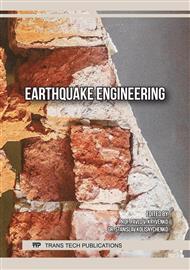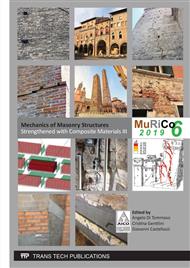[1]
G. Tumialan, F. Micelli, A. Nanni, Strengthening of masonry structures with FRP composites, In Proc. of Structures Congress, Washington DC, (2001).
DOI: 10.1061/40558(2001)130
Google Scholar
[2]
G. de Felice, S. De Santis, L. Garmendia, B. Ghiassi, P. Larrinaga, P.B. Lourenco, et al., Mortar-based systems for externally bonded strengthening of masonry, Mater. Struct. 47 (2014) 2021-2037.
DOI: 10.1617/s11527-014-0360-1
Google Scholar
[3]
F.G. Carozzi, C. Poggi, Mechanical properties and debonding strength of fabric reinforced cementitious matrix (FRCM) systems for masonry strengthening, Compos. Part B 70 (2015) 215-230.
DOI: 10.1016/j.compositesb.2014.10.056
Google Scholar
[4]
T. D'Antino, C. Carloni, L.H. Sneed, C. Pellegrino, Matrix-fiber bond behavior in PBO FRCM composites: A fracture mechanics approach, Engineer Fracture Mechanics 117 (2014) 94-111.
DOI: 10.1016/j.engfracmech.2014.01.011
Google Scholar
[5]
F. Focacci, T. D'Antino, C. Carloni, L.H. Sneed, C. Pellegrino, An indirect method to calibrate the interfacial cohesive material law for FRCM-concrete joints, Mater. Design 128 (2017) 206-217.
DOI: 10.1016/j.matdes.2017.04.038
Google Scholar
[6]
T. D'Antino, L.H. Sneed, C. Carloni, C. Pellegrino, Effect of the inherent eccentricity in single-lap direct-shear tests of PBO FRCM-concrete joints, Compos. Stru. 142 (2016) 117-129.
DOI: 10.1016/j.compstruct.2016.01.076
Google Scholar
[7]
D'Ambrisi A, Feo L, Focacci F, Experimental analysis on bond between PBO-FRCM strengthening materials and concrete, Compos. Part B 44(1) (2013) 524–532.
DOI: 10.1016/j.compositesb.2012.03.011
Google Scholar
[8]
T. D'Antino, F.G. Carozzi, P. Colombi, C. Poggi, A New Pull-Out Test to Study the Bond Behavior of Fiber Reinforced Cementitious Composites, Key Eng. Mater. 747 (2017) 258-265.
DOI: 10.4028/www.scientific.net/kem.747.258
Google Scholar
[9]
RILEM/CEB/FIP Recommendations on reinforcement steel for reinforced concrete. Revised edition of: RC5 Bond test for reinforcement steel: (1) Beam test. Comité Euro-International du Beton, CEB News No 61. Paris April (1982).
DOI: 10.1201/9781482271362-155
Google Scholar
[10]
C.G. Hoover, Z.P. Bazant, Comprehensive concrete fracture tests: Size effects of Types 1 & 2, crack length effect and postpeak, Eng. Fract. Mech. 110 (2013) 281-289.
DOI: 10.1016/j.engfracmech.2013.08.008
Google Scholar
[11]
ACI 440.9R-15, Guide to accelerated conditioning protocols for durability assessment of internal and external fiber-reinforce, Farmington Hills, MI, American Concrete Institute, (2015).
Google Scholar
[12]
C. Carloni, S. Verre, L.H. Sneed, L. Ombres, Loading rate effect on the debonding phenomenon in fiber reinforced cementitious matrix-concrete joints, Compos. Part B 108 (2017) 301-314.
DOI: 10.1016/j.compositesb.2016.09.087
Google Scholar
[13]
H.W. Zhang, S.T. Smith, FRP-to-concrete joint assemblages anchored with multiple FRP anchors, Compos. Struct. 94 (2012) 403-414.
DOI: 10.1016/j.compstruct.2011.07.025
Google Scholar
[14]
CSLLPP, Linea Guida per la identificazione, la qualificazione ed il controllo di accettazione di compositi fibrorinforzati a matrice inorganica (FRCM) da utilizzarsi per il consolidamento strutturale di costruzioni esistenti, January (2019).
DOI: 10.3221/igf-esis.12.04
Google Scholar
[15]
L.H. Sneed, T. D'Antino, C. Carloni, C. Pellegrino, A comparison of the bond behavior of PBO-FRCM composites determined by double-lap and single-lap shear tests, Cement Concr. Comp. 64 (2015) 37-48.
DOI: 10.1016/j.cemconcomp.2015.07.007
Google Scholar
[16]
F.G. Carozzi, A. Bellini, T. D'Antino, G. de Felice, F. Focacci, et al., Experimental investigation of tensile and bond properties of Carbon-FRCM composites for strengthening masonry elements, Compos. Part B 128 (2017) 100-119.
DOI: 10.1016/j.compositesb.2017.06.018
Google Scholar
[17]
C. Carloni, F. Focacci, FRP-masonry interfacial debonding: An energy balance approach to determine the influence of the mortar joints, Eu. J. of Mech., A/Solids 55 (2016) 122-133.
DOI: 10.1016/j.euromechsol.2015.08.003
Google Scholar
[18]
M. Malena, Closed-form solution to the debonding of mortar based composites on curved substrates, Constr. Build. Mater. 139 (2018) 249-258.
DOI: 10.1016/j.compositesb.2017.11.044
Google Scholar



